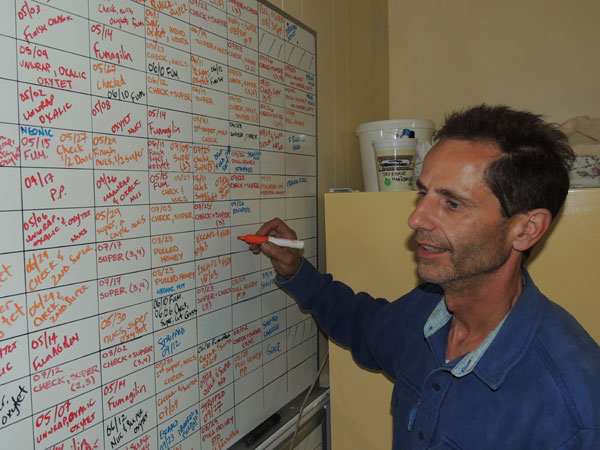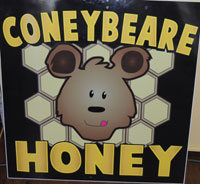Jim Coneybeare

With approximately 850 hives, Jim has three full time staff that he treats like family and relies on to help accomplish everything that is done each day. His bees are used for pollination and can be found on farms in Wellington and Grey Counties and extending a couple hours further north. Considering bee health important, Jim is focused on using responsible management practices. Though he has raised queens for sale in the past, this year he did not. Still, he does have a queen breeding program in place to establish and maintain genetically healthy hives.
“He’s very detail oriented,” explains Ashley, who has worked for Jim about eight years. “He stays on top of treatments and gives the bees extra attention that other beekeepers may not.” As a result, Jim’s hives have an almost undetectable mite load and he averages no more than three to 10 percent winter losses, regardless how far north his bees are.
His attention and care for the bees might be attributed to his upbringing. Jim began visiting bee yards with his mentor, his father Verne, when he was just three or four years old. As a third generation beekeeper from a family with a strong history of beekeeping – Jim’s maternal grandfather began keeping bees in 1925 and Jim still has an uncle and a cousin that keep bees today – it isn’t surprising that Jim took over the family business in 1996 when his father died suddenly of a heart attack.
“I enjoy being outside,” says Jim. He went to college to become a Certified Engineer Technician / Technologist and worked in construction for 10 years, and will tell you the only thing he misses is the paycheck.
“I enjoy working with nature to produce something – and that’s what bees are essentially. You are working with nature to produce something. Beekeeping is, in my mind, everything from genetics to sales.”
Packing honey is a year round activity and a major part of Jim’s business. Though he sells the wax that is a by-product of extraction, he mainly supplies wholesale, direct to retail and industrial use honey to customers that range from health food suppliers to bakery products and farmer’s markets. He invested in a Cowan extracting line two years ago and fully enjoys it.
“In this business, you have to do whatever you can to save your back,” Jim says, “and to save yourself labour. If you have to move bees, figure out a way to palletize your bees so you are not having to hand-bomb hives. I’ve got an articulating bobcat for loading bees and love it because it saves my back. It’s more developing equipment and a program that works.”
Working with Diane Krout and the Wellington County Beekeepers’ Association, in 2007 Jim helped develop winter wraps to insulate hives through our Canadian winters. The proceeds from sales of the wraps are donated to OBA’s Tech Transfer Program and have generated approximately $20,000 in revenue, to date.
One unique beekeeping practice that Jim has is to overwinter some of his bees in shallow brood chambers. When he moved to a pallet system, he no longer needed to run story-and-a-half chambers that he originally implemented because they were easier to hand-bomb. This left him with a number of 6 5/8” brood chambers to find a use for. That winter, he successfully kept about 20 hives in the shallow chambers and now runs about 150 hives this way. He pays a little more attention in the fall to make sure the bees don’t starve, uses a deep rim and says the bees winter as well or better as those in larger chambers.
“There’s a slightly smaller cluster in the winter,” Jim states, “but bees naturally like smaller areas. And in the summer there really is no difference. Going into the winter, a shallow chamber will weigh 75 – 80 lbs. with 10 frames of brood; 50 lbs. of that would easily be feed stores.”
When asked his favourite time of year, Jim says he rolls with the season. “In the spring, it’s exciting to unwrap bees,” Jim says, “and then it’s exciting to go through summer and see the honey flow. By the fall, you are so tired that you are glad to wrap the hives and in winter, you look forward to sleeping an hour longer.”
It is rare for Jim to take long holidays, though he will try for the occasional long weekend away with his wife Tracy, daughters Amber and Amanda, and son Elijah. Jim enjoys playing the mandolin, though he has precious little spare time for it. Instead, his spare time is spent dedicated to the beekeeping industry as a member of organizations such as the Ontario Bee Breeders’ Association, the Wellington County Beekeepers’ Association and as a director of the Ontario Beekeepers’ Association. More recently, Jim became involved on the Ontario Bee Health Working Group – a responsibility that has almost become its own full time job.
“Neonics are such a challenge in the environment,” says Jim, “and they are beyond our control. Where do we go to get away from them?”
While Jim has had great success, experiencing very little loss in past years, more recently he’s seeing smaller bee numbers, less honey and poorer overall hive health – all of which he attributes to pesticide poisoning. Though he may not always see the dead bees, he has seen his average honey crop drop from between 110 – 150 lbs. down closer to 30 – 35 lbs. per hive this year and is concerned that he will have to lay off staff as a result.
“I’d like to see neonics banned because we are seeing so much residue in the environment and bees exposed,” states Jim. “It’s not like any other challenge we face as beekeepers. We can treat for varroa mites and disease. Even with American Foul Brood we can burn hives and build new boxes. It’s extreme, but we can start again. But with pesticides, there is no method of treatment. And if it carries on there’s no future for the bees.”
Despite his concern about pesticides, the environment and the future of the bee industry, Jim isn’t ready to give up beekeeping yet. If all goes well, he foresees spending another 20 years as a commercial beekeeper and finishing out his career with enough hives to stay in it as a hobby. He quotes an old saying: “beekeepers never die; they just buzz off.”


